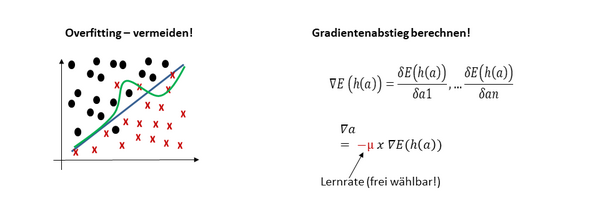AI - Risks
In addition to the many good possibilities and high potential benefits of artificial intelligence in production engineering, there are also risks to be considered when implementing such capability tools.
On the one hand, there are risks with regard to a possible malfunction of "artificial intelligence" and the resulting loss of productivity and profitability. Malfunctions, on the other hand, have their origin both in inappropriate mathematical modelling (algorithms), incorrect parameterisation (production coefficients) of these algorithms and an insufficient number of data that meet requirements (good data), in order to ensure that the mathematical model always optimises itself and in the correct manner, see also the previous chapter.
In the course of the application of an artificially intelligently controlled production environment, the user of the digitization technology will definitely be confronted with the following questions, which should at best be addressed preventively, within the planning phase of such projects:
- Has the optimization goal been chosen correctly and is it still valid?
- With which quality is the optimization goal achieved (goal evaluation)?
- Who evaluates the optimization quality?
- Which boundary conditions in the production system relevant to the optimization goal have changed?
- How exactly was the plausibility check of the mathematical representation (validation) carried out?
- When did the last valid validation of the mathematical model take place?
- Is the statement of the plausibility checkers comparable?
- Is there a clear documentation of the plausibility check / validation (audit)?
- Were the correct algorithms for machine learning selected?
- Are these algorithms (type & kind) still suitable for the optimization goal?

- Are the existing control variables (production coefficients) correctly selected or do they have to be readjusted to changed production conditions of the user?
- Are there any programming errors within the mathematical model?
- Do the sensor solutions used function sustainably and with what error rate? -> How does the quality of information develop over time?

- Who evaluates the development of the quality of information?
- Where do I get the AI hardware, the data acquisition system from?
- Is it a home-made solution or the solution of a service provider?
- Who adapts the hardware - how high is the potential to evaluate possible sources of error due to outdated or worn hardware?
- Who guarantees the sustainable function of the data acquisition system and its software updates?
- How do you want to ensure the availability of the data acquisition system - via in-house construction or external service?
- Are the algorithms checked and monitored at regular intervals, and their optimization quality and capability tested and improved?
- Are methods of deductive - or purely inductive learning already used?
- What is the deduction approach based on - are there sources of error with regard to the expert knowledge used?
- Has this expert knowledge been tested in terms of content?
- Is the technical theory as knowledge base of the deductive learning approach of your artificial intelligence fully valid? Do changed production conditions have to be checked regularly and their influence as a cause of error excluded?
- Who evaluates these digitization topics in your company - How reliable is the statement of the employees - How can it be controlled?
- Is there a sufficiently high level of expertise in setting up the digitisation infrastructure?
- Is the topic sustainably controllable? Or does the production control system become unintentionally independent?
If such questions remain unanswered, they provide a first framework for assessing the risks of using such an optimization assistance. A healthy compromise has to be found with regard to the ability of the in-house performance in the context and at the same time the acceptance of external service providers (e.g. the hardware of data acquisition systems) without being dependent on individual employees or external third parties and without losing production information (your production know-how) to third parties.
In this article relevant products:
These articles from our magazine may also interest you:
AI - What is this?
Basically, the concept of artificial intelligence is technically misplaced in this context. Artificial intelligence describes the academic endeavours of humans to research the human brain and its performance and to map it with the help of computer-aided methods.
AI - Obstacles
The often predominant irritation of the decision makers responsible for production is currently still the biggest obstacle to the implementation of digitisation technology in companies.
AI - Challenges
The challenge of using artificial intelligence in production engineering is to generate data whose values are as correct as possible (good data).
Error in the lubricoolant system
Modern large-scale production of metallic components often has large and equally complex cooling lubricant systems. Keeping all parameters in view and ensuring reliable operation is therefore not trivial. Coolant monitoring systems can be used to support the monitoring of the coolant system.








